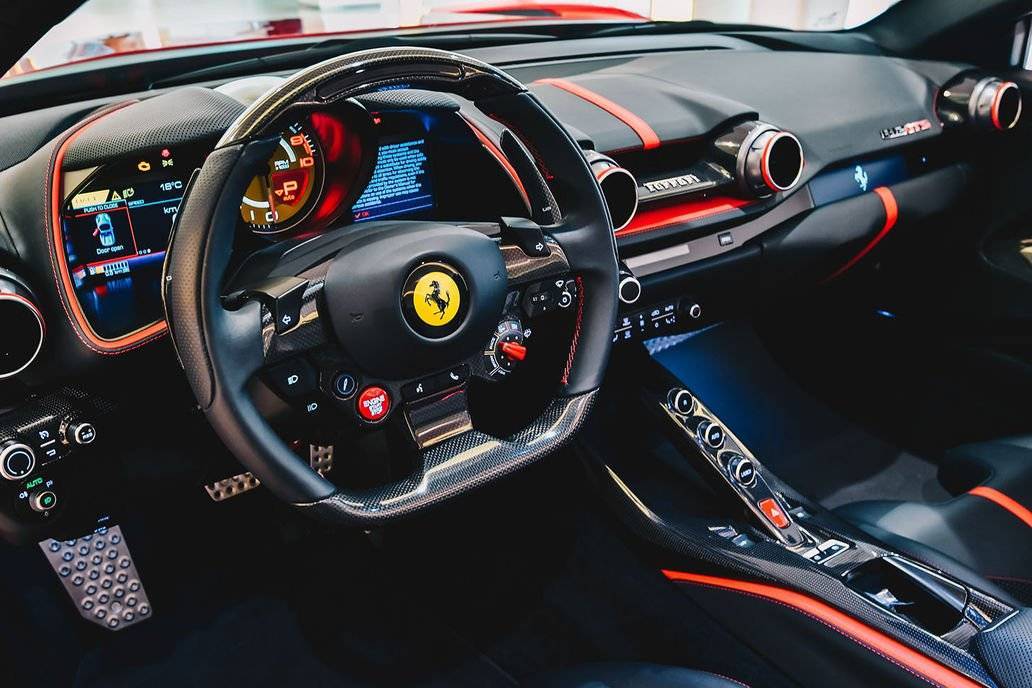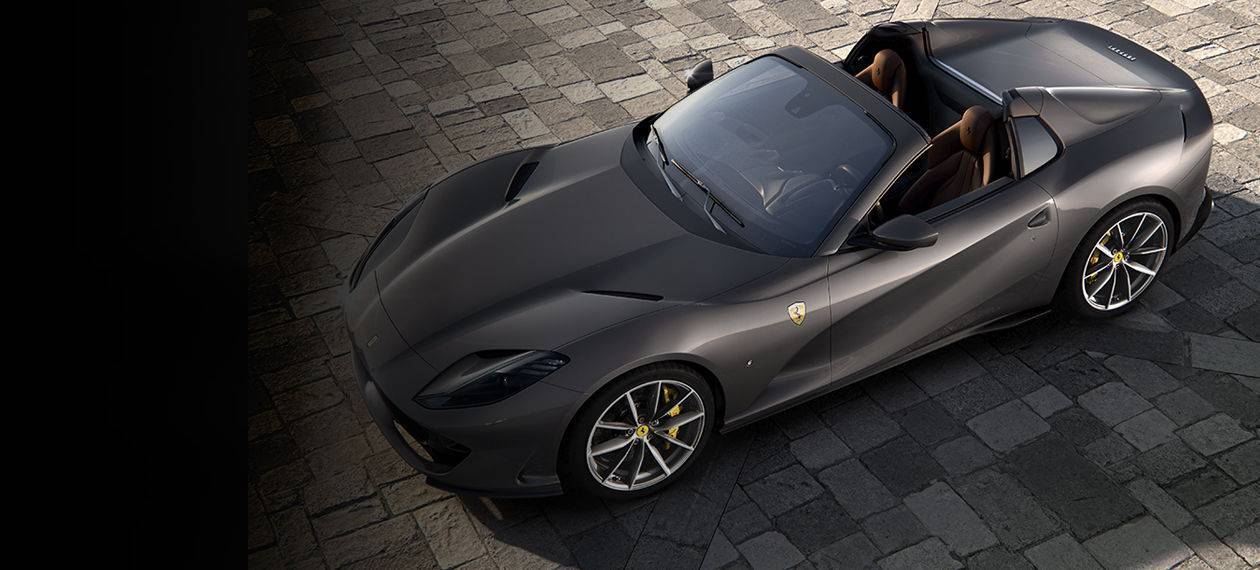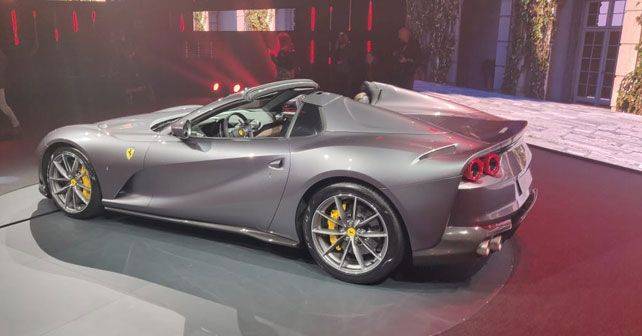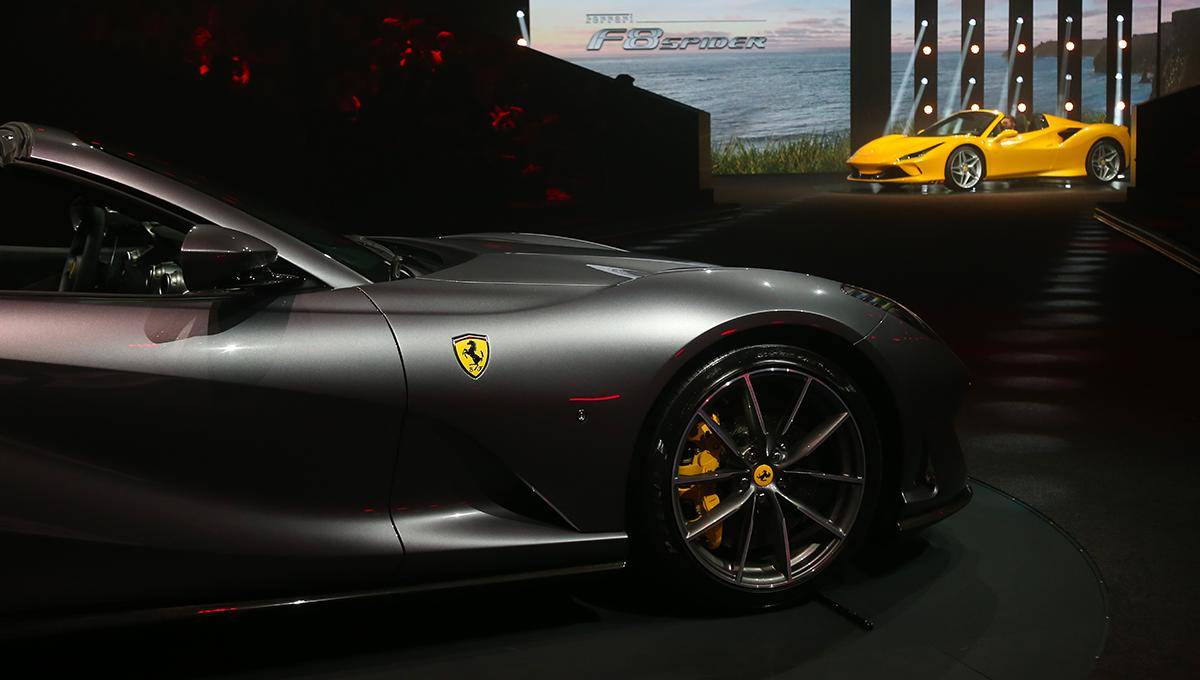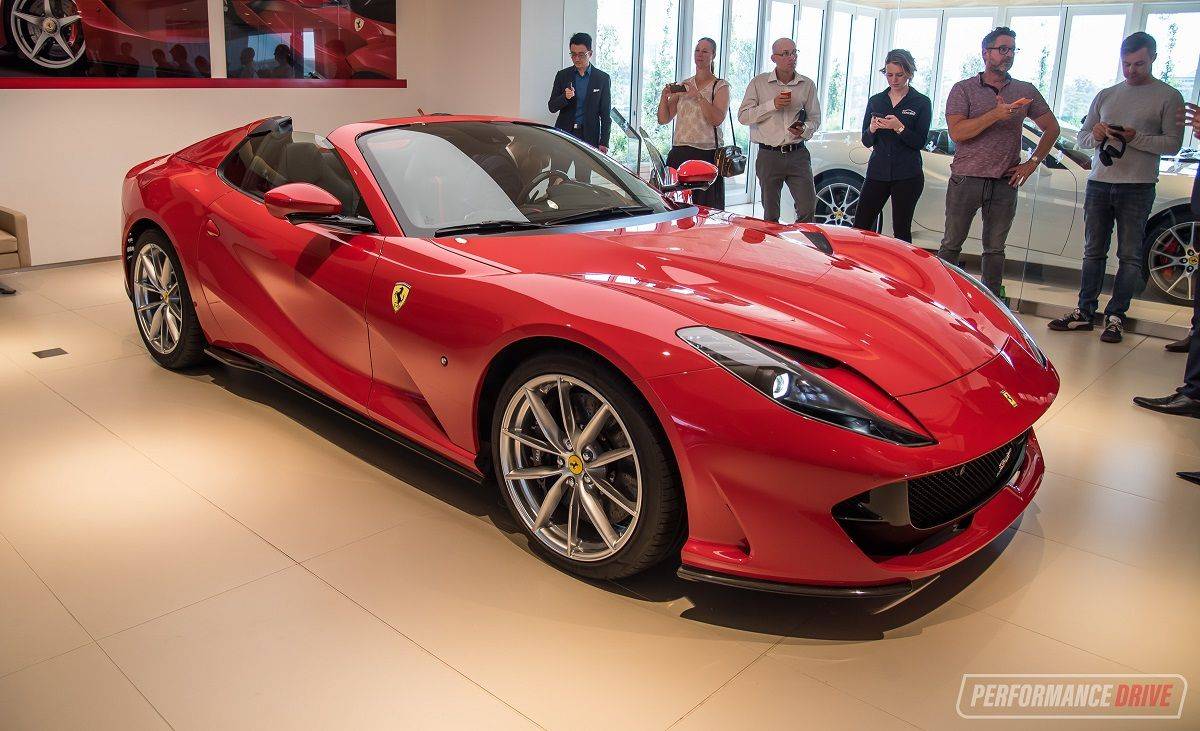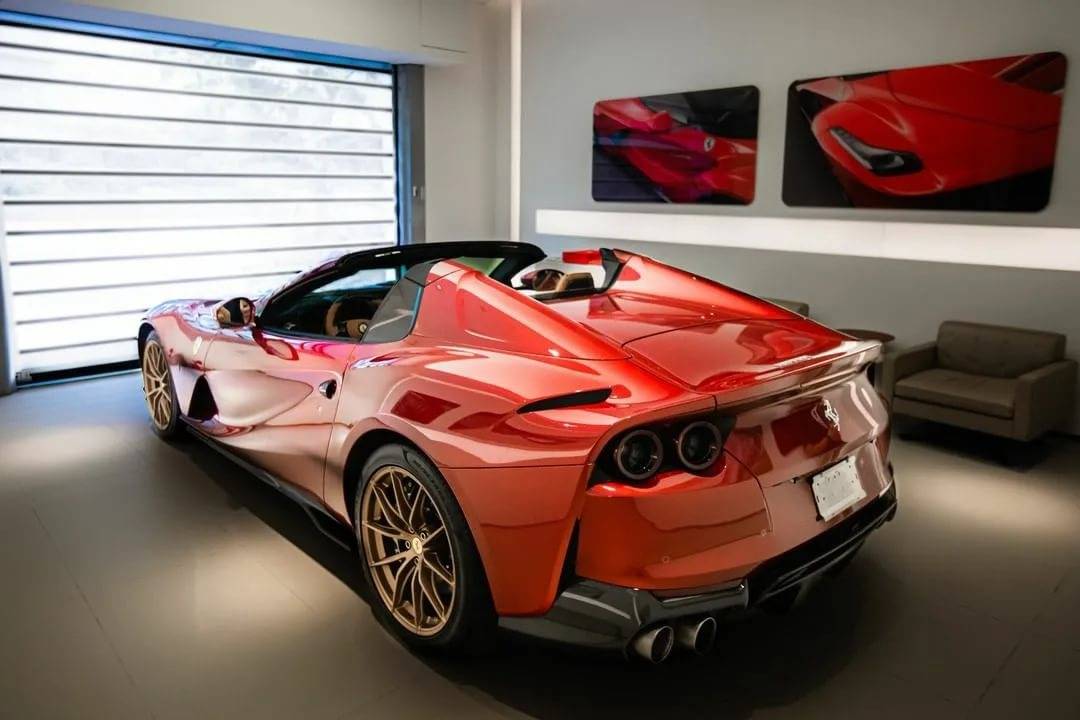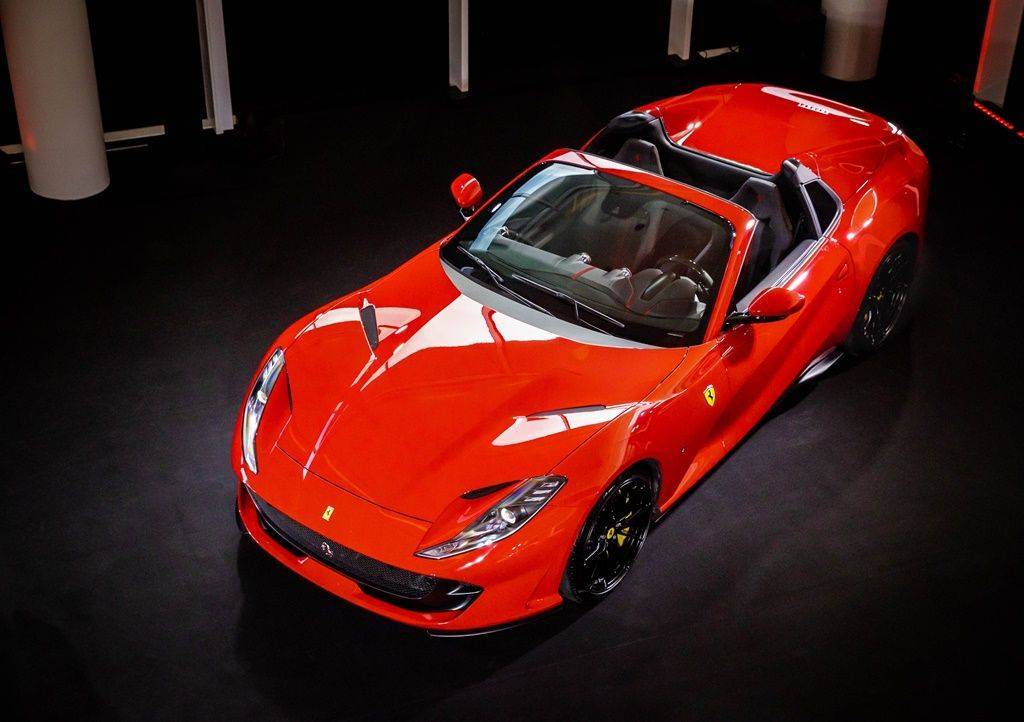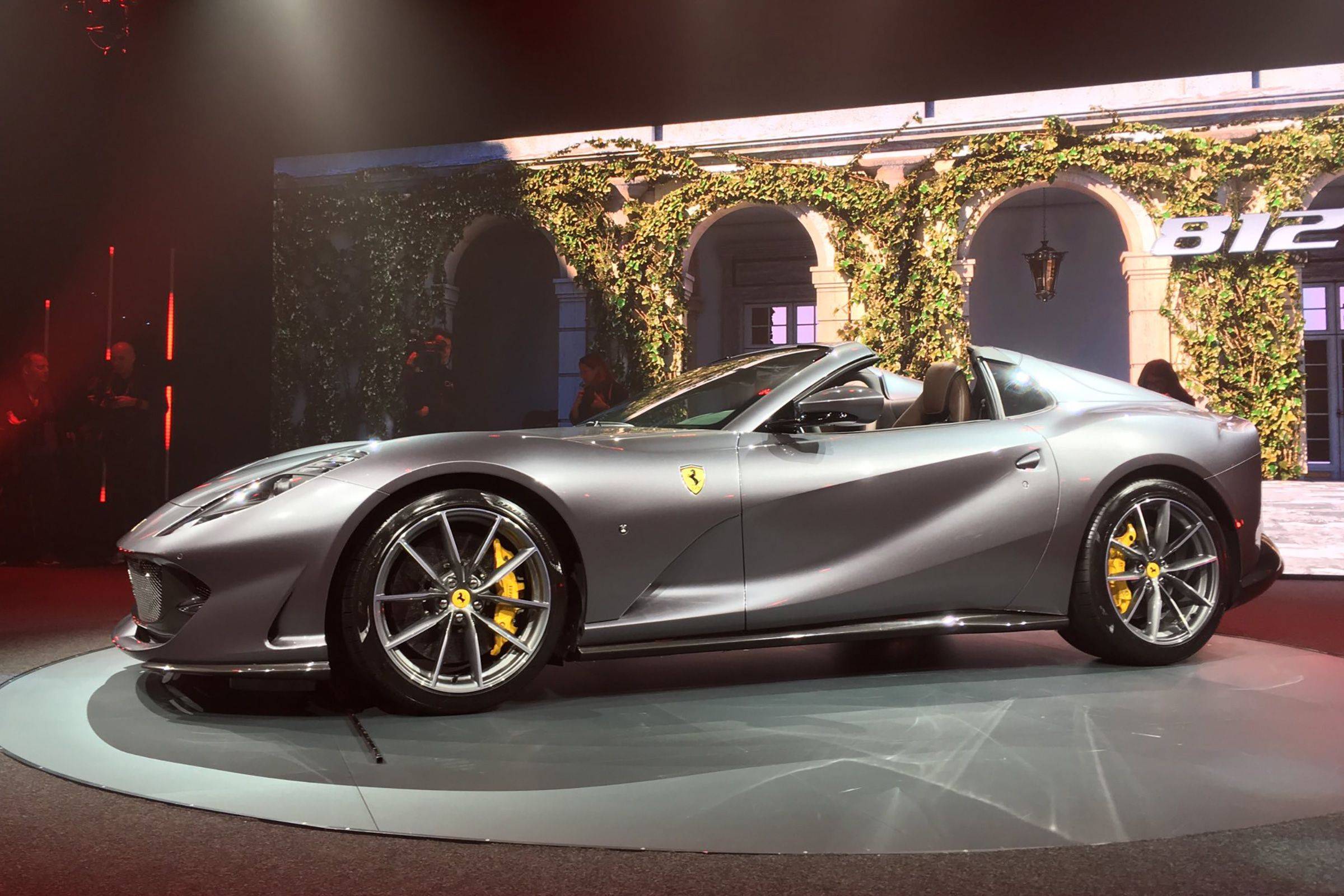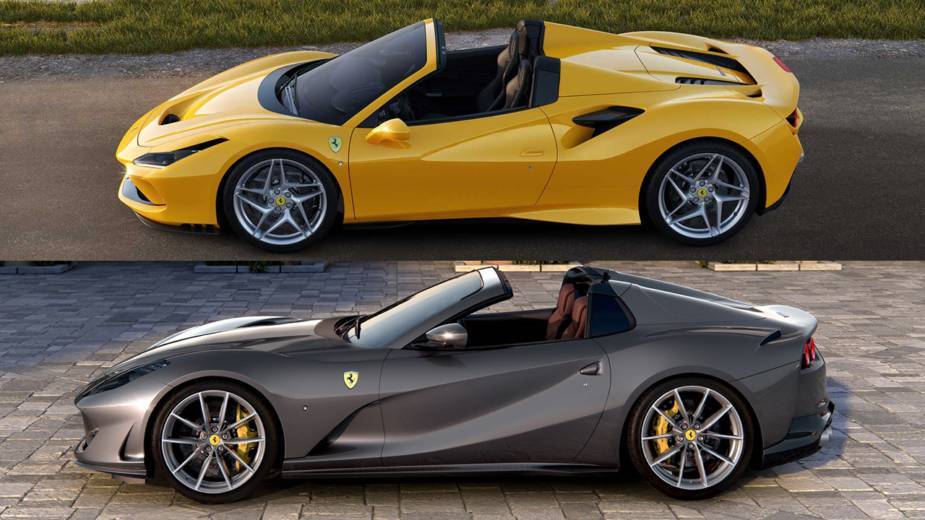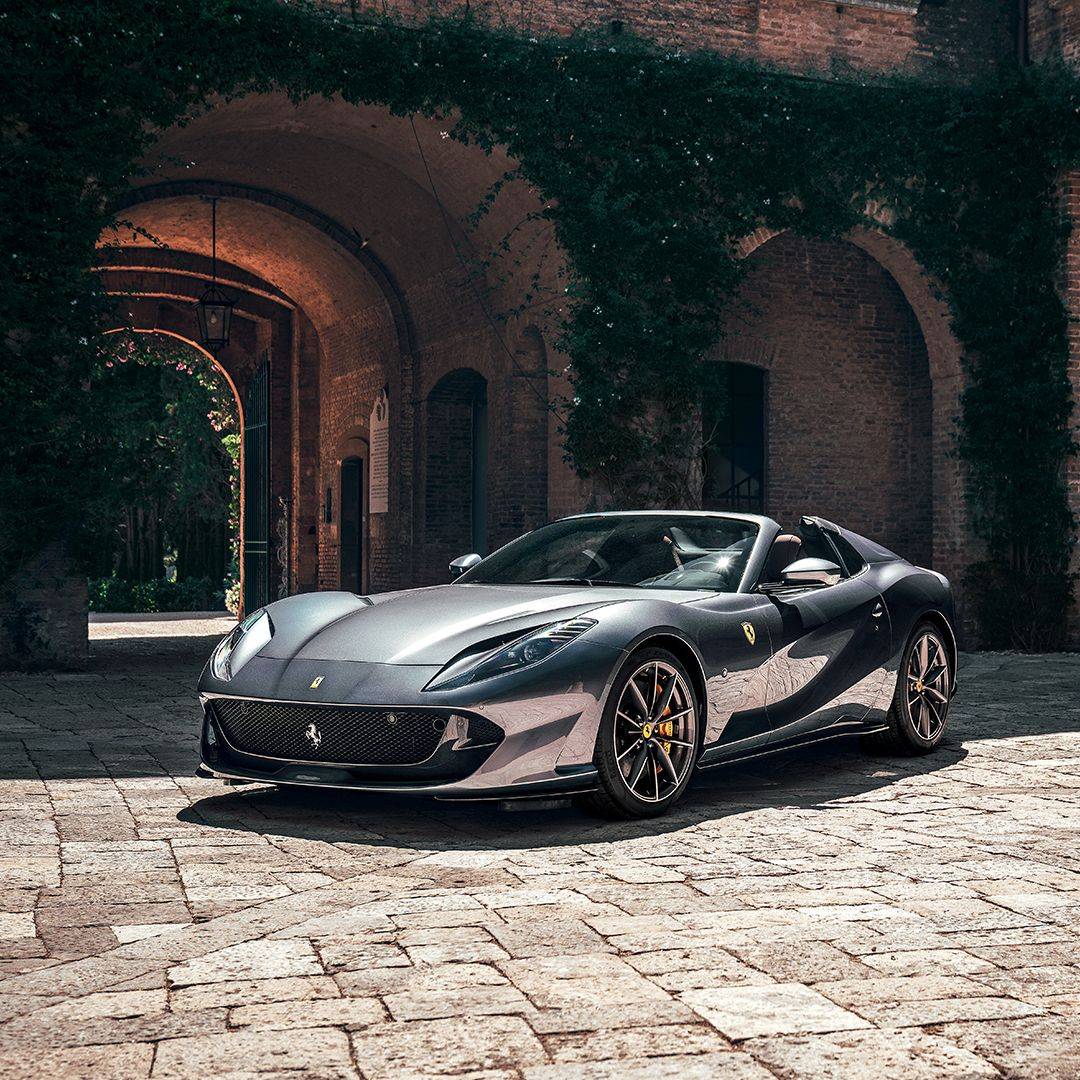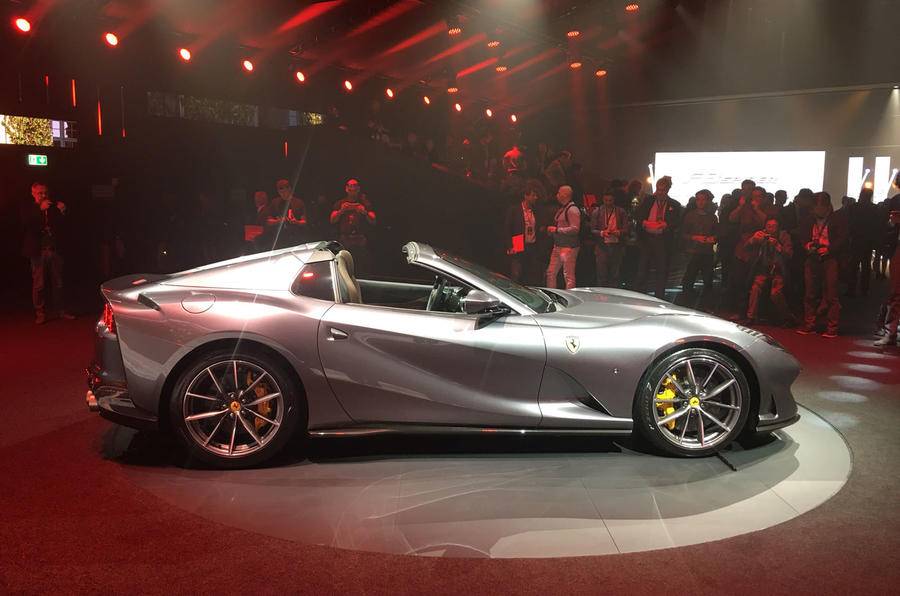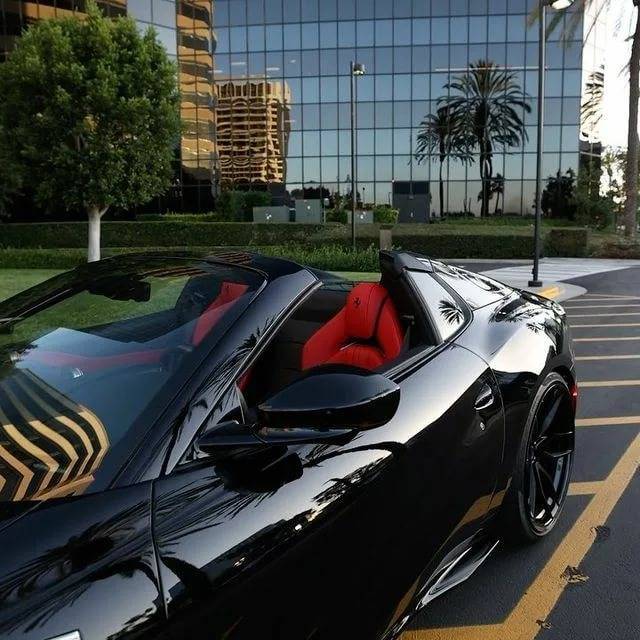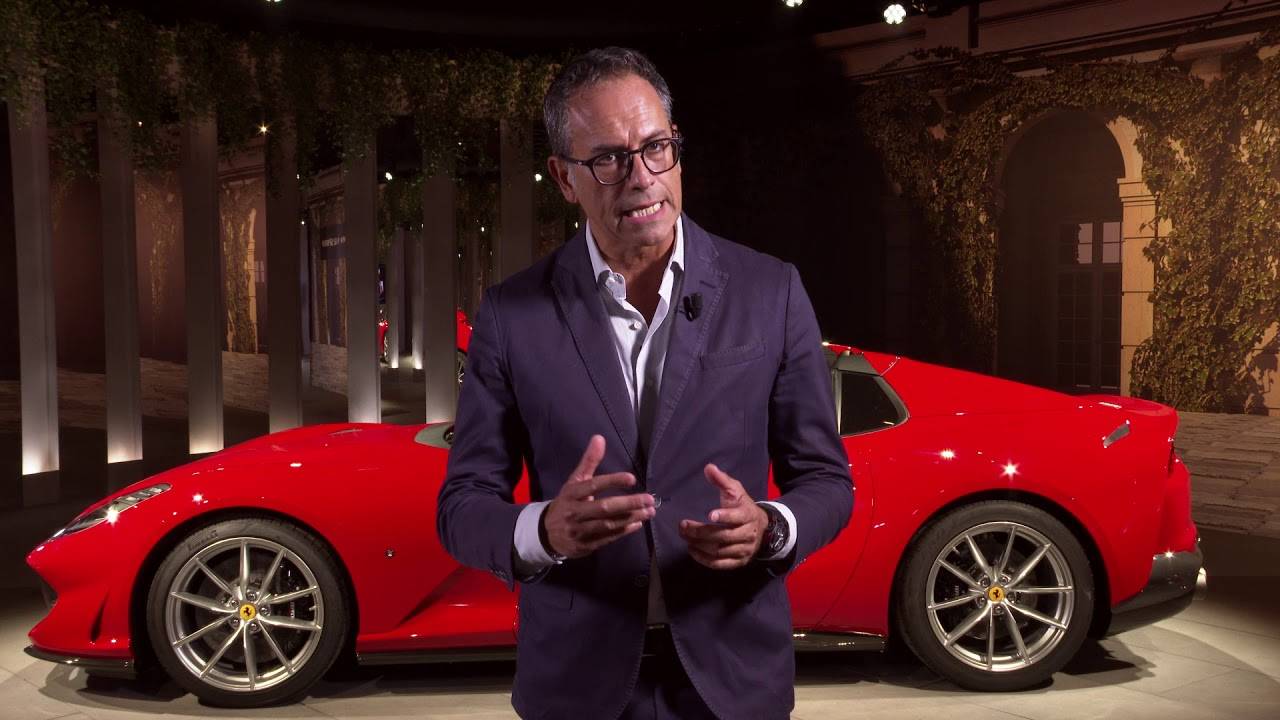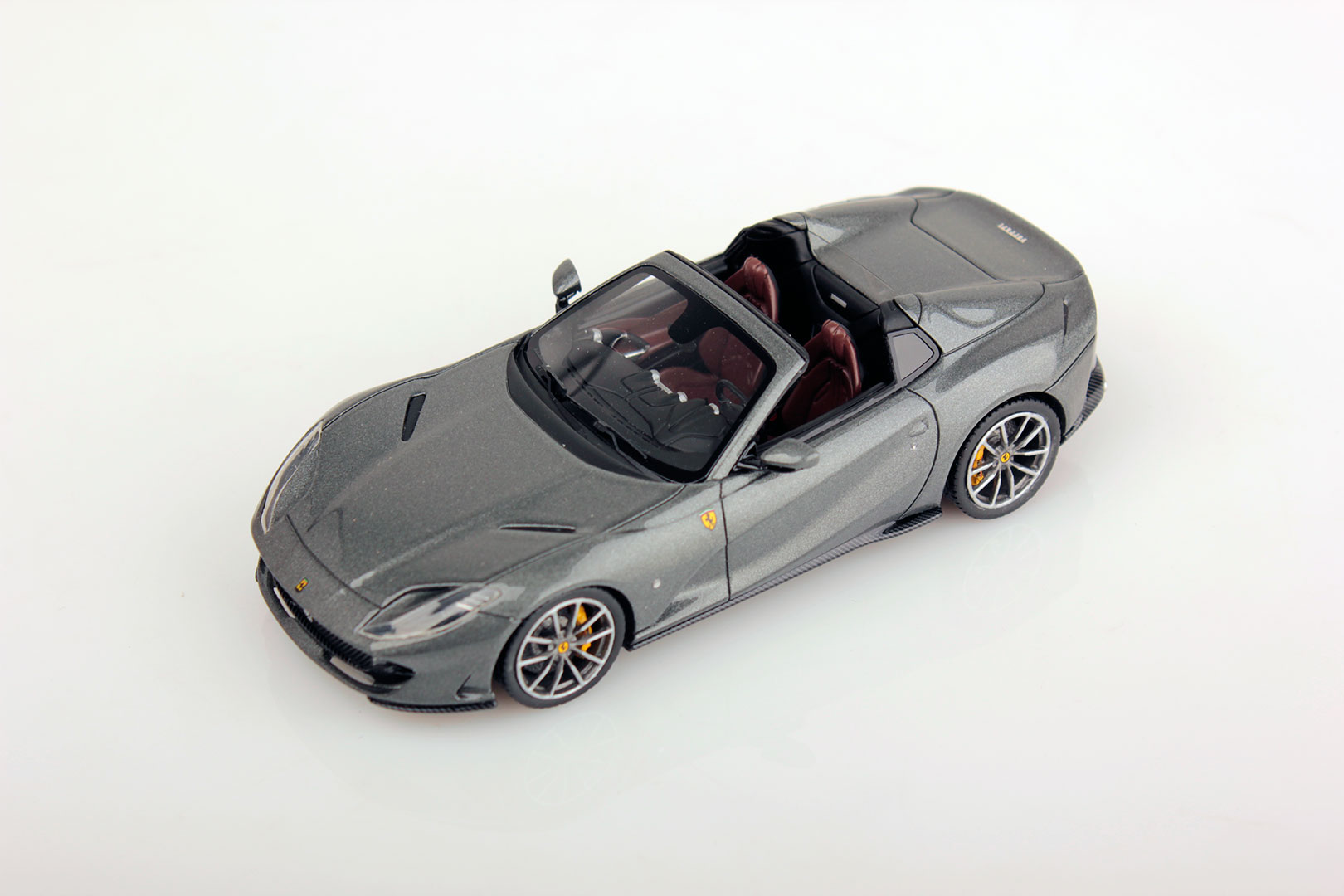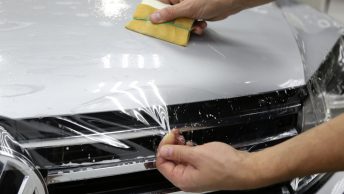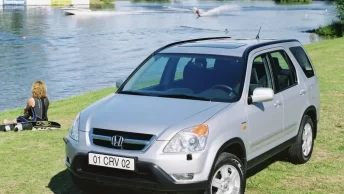Pushing on in the twisties
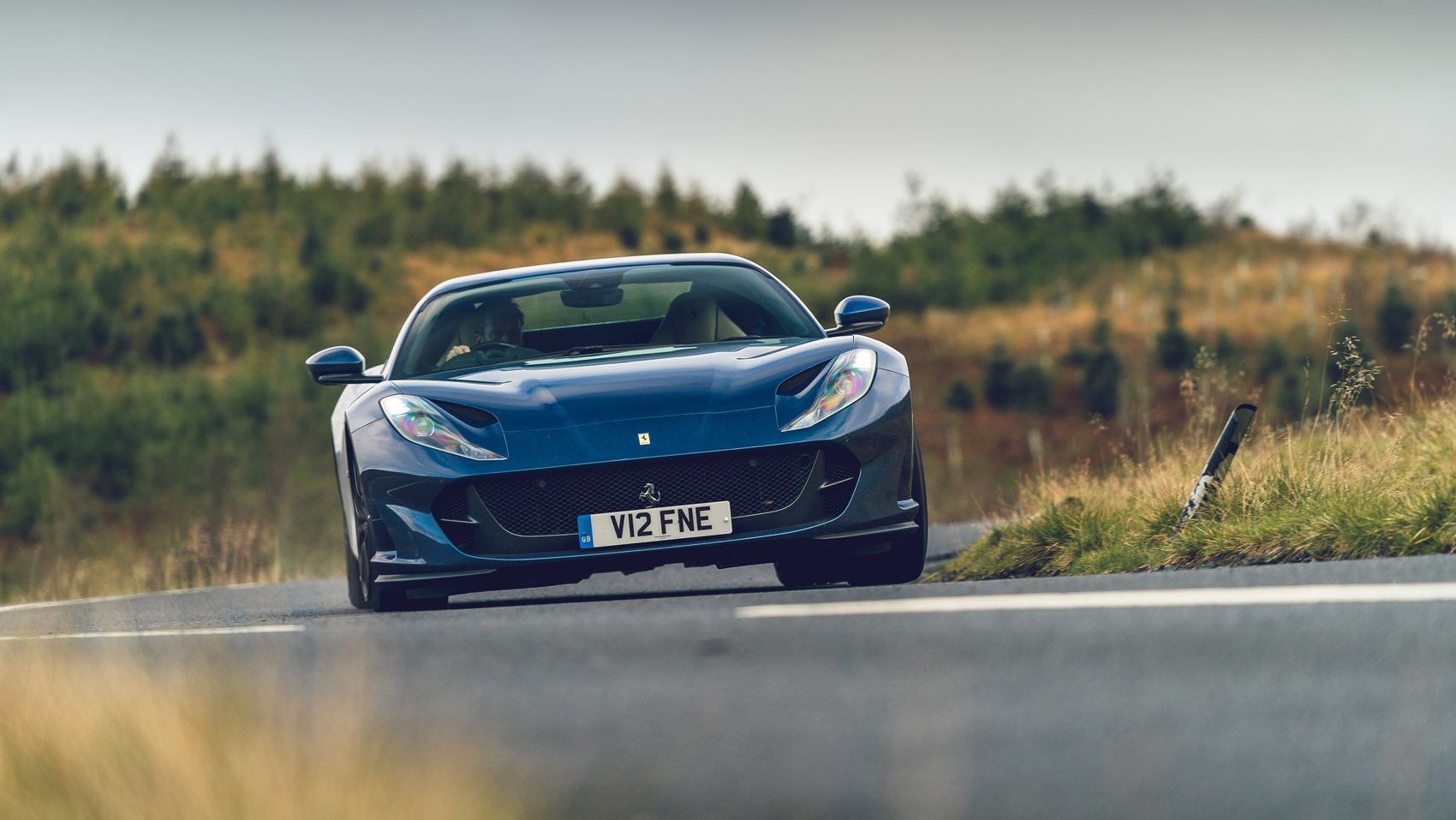
As time progresses, I’m beginning to feel more comfortable working the GTS harder, if still pondering whether I’d trade some agility for a calmer kind of feel on fast roads like this – as well as whether I actually want to disengage all safety systems to discover how this chassis really behaves. There’s definitely more of an edge to these dynamics than Ferrari’s mid-engined models.
Out in the chilly countryside, the roads we’ve picked have significant undulation and tighter twists and turns, so you don’t need quite so much commitment to really dig in to this extraordinary chassis. What you do need is tyre temperature. There’s a graphic to the right of the 812’s steering wheel that shows when the Pirellis are warmed, and in the cold and damp it takes an age for the tyres to go ‘green’, the fronts first as I work the steering hard, the rears later as I’m being a bit throttle shy. Then bingo, four green tyres, more grip, virtuous circle.
It’s actually startling to feel out just how much mechanical grip the 812 can muster with ESC off, even in damp and cold conditions. Push through that grip with a bung of steering and squirt of throttle and it immediately wants to bite and straighten, almost like the stability control isn’t entirely disabled, and certainly with far more aggression than an F8 – clearly the four-wheel steering feeds in here, but apparently the new electric steering also adds subtle torque hints to help a driver correct slides. I can’t say I process any of that stuff working away, just that the GTS responds better to big sends than tentative squirts past its limits. I’ve never driven a car that wants to straighten quite so aggressively, and together with yelps from the V12 this feels as close to lion-taming as you’ll get on four wheels.

But breaching its limits helps me fully trust the 812 GTS. It’s grippy, unbelievably agile, and so easy for throttle, gearshifts, brakes and steering to gel into a fast and smooth tempo, even if I never quite shake the lurking apprehension that this near-800bhp rear-drive weapon is a very senior piece of machinery. Respect is definitely due, in both senses of the phrase.
With the sun warming the sky, I squeeze that V12 past 5500rpm, unleashing a hedonistic rush of noise and speed as the needle breaches 8500rpm with the sound distilled into a fierce single-note howl. Modern turbocharged engines are marvellous things, but the response, linearity, sound and sheer bandwidth delivered here are all reminders of what we’ve lost in the march of progress – and Ferrari assures us the naturally-aspirated V12 is here for the long term, even if it is hybridised. Amen to that.
Обзор
В попытках уменьшить аэродинамическое сопротивление кузова итальянцы заменили почти все его детали. Помимо нового «оперения», расположившегося на кузовных элементах, там же появились воздуховоды иных форм и размеров, причем новую систему отвода воздуха пришлось организовать и из-под капота
Отдельное внимание было традиционно уделено воздухозаборникам, предназначенным для охлаждения радиаторов и тормозов, а также форме днища
Наконец, была успешно решена задача и по упорядочиванию воздушных потоков в задней части авто, где вместо стекла на версии купе появился необычный алюминиевый обтекатель. На тарге Ferrari 812 Competizione A эту роль доверили специальной поперечине, также спроектированной с оглядкой на «правильную» аэродинамику.
Одной из многочисленных целей, традиционно стоящих перед конструкторами спорткаров, выступает снижение массы авто. Благодаря появлению углепластиковых элементов кузова, новых колесных дисков и слегка облегченному двигателю новая 812-я стала легче на 38 кг. (1487 кг.) Также инженеры изменили развесовку по осям, но это было вызвано, главным образом, небольшими изменениями в шасси.

Помимо новых дисков и специально разработанных для данной модели покрышек Michelin Cup 2 R, на Competizione появились индивидуальные актуаторы для задних колес (ранее использовался один на всю ось). Считается, что тем самым небольшие довороты колес должны стать более точными, что положительно скажется на управляемости спорткара.
Техническая начинка
Итальянцы изначально не планировали превращать 812 Superfast в машину с гибридным двигателем, поскольку это вынудило бы избавиться от имиджевого мотора V12. Но для Competizione было решено подготовить модернизированную версию прежнего 6.5-литрового агрегата.
Мотору заменили шатуны, поршни, коленвал, масляный насос и систему впрыска, добившись улучшений в самых разных аспектах работы силовой установки. Это и уменьшение трения распредвалов, и увеличение отсечки до 9500 об/мин, и менее вязкое моторное масло. В сухих цифрах двигатель прибавил 30 л. с. мощности и стал 830-сильным, хотя показатель вращающейся тяги уменьшился с 718 до 692 Нм.
 Салон настоящего суперкара, без лишних мониторов и отвлекающих вещей.
Салон настоящего суперкара, без лишних мониторов и отвлекающих вещей.
Динамика же вовсе изменилась незначительно: на разгон до 100 км/ч у Ferrari 812 Competizione уходит 2,85 секунды вместо 2,80 у прежней 812 Superfast. «Максималка» осталась на уровне 350 км/ч, что, впрочем, «решается» электроникой, а не самим двигателем.
Цены и старт продаж
В планах итальянской компании выпустить 999 автомобилей Ferrari 812 Competizione и 599 тарга-версий Aperta. Стоимость купе в начальной модификации, не предусматривающей возможное наличие некоторых опций индивидуализации, составляет 499 тысяч евро (45 млн рублей), а машина с открытым верхом оценивается в 578 тысяч.
Правда, купить новые спорткары уже не удастся. Все потому, что все 1598 автомобилей уже распроданы, а первые экземпляры отправятся своим владельцам весной 2022 года.

Ferrari 812 GTS получил 789 лошадей и максималку в 340 км/ч
Вслед за дебютом F8 Spider, Ferrari представила еще один кабриолет. Созданный на базе купе 812 Superfast с двигателем V12, новый 812 GTS позиционируется как самый мощный кабриолет, который вы можете купить, благодаря атмосферному 6,5-литровому V12, развивающему 789 лошадиных сил и 718 Нм крутящего момента.
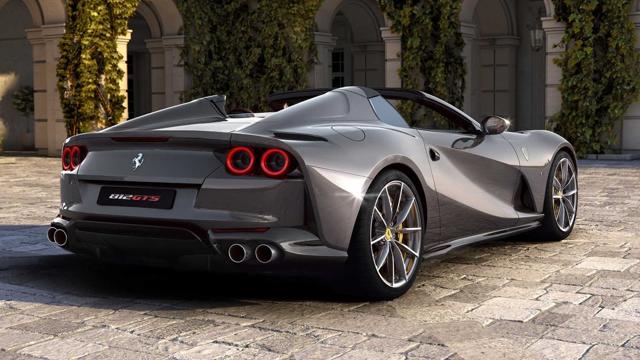
Чтобы осознать эти цифры полностью, стоит упомянуть, что новый кабриолет из Маранелло затмевает не только кабриолет Chevrolet Corvette ZR1 (C7) с его мощностью 755 л.с. от 6,2-литрового V8 с компрессором, но и родстер Lamborghini Aventador SVJ мощностью 759 л.с. от атмосферного 6,5-литрового V12.
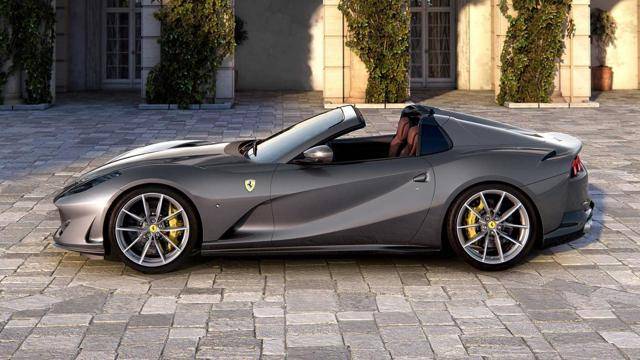
Полный объем мощности доступен с 8500 об/мин, но V12 на самом деле может крутиться до 8900 об/мин, а полный крутящий момент доступен от 7000 об/мин. Однако 80% крутящего момента начинаются уже с 3500 об/мин, поэтому 812 GTS должен быть настоящей ракетой при резком ускорении.

Новый 812 GTS разгоняется до сотни менее, чем за три секунды – всего на десятые доли секунды медленнее, чем его брат с фиксированной крышей. До 200 км/ч он может разогнаться всего за 8,3 секунды – на 0,4 секунды медленнее, чем купе. Максимальная скорость составляет те же 340 км/ч, что и у Superfast.

Как и F8 Spider, о котором мы упоминали раньше, 812 GTS использует элетропривод складывания крыши, которому требуется всего 14 секунд на скорости до 45 км/ч, чтобы сложить или поставить крышу на место.
Как и в случае с любым другим кабриолетом, складная крыша потребовала некоторого усиления шасси, что сказалось на весе, поскольку Ferrari пришлось прибавить в весе 75 кг.
Несмотря на прибавку в весе, 812 GTS считается таким же “эластичным”, как и купе, благодаря специально откалиброванным магнитореологическим амортизаторам.

Туз в рукаве 812 GTS – это заднее стекло с электроприводом, выполняющее роль ветрозащиты. Это делает автомобиль более приятным и комфортным, когда верх опущен и позволяет великолепному звуку V12 лучше проникать в кабину.

В завершение стоит упомянуть, что 812 GTS – это фактически первая серийная модель V12 Spider от Ferrari, выпущенная за последние 50 лет, после 365 GTS4 a.k.a. Daytona Spider 1969 года.
В течение полувека существовали и другие дроптопы с V12, но такие модели, как 550 Barchetta Pininfarina 2000 года, 575 Superamerica 2005 года, SA Aperta 2010 года и F60 America 2014 года, выпускались в ограниченном количестве.
Pushing on in the twisties
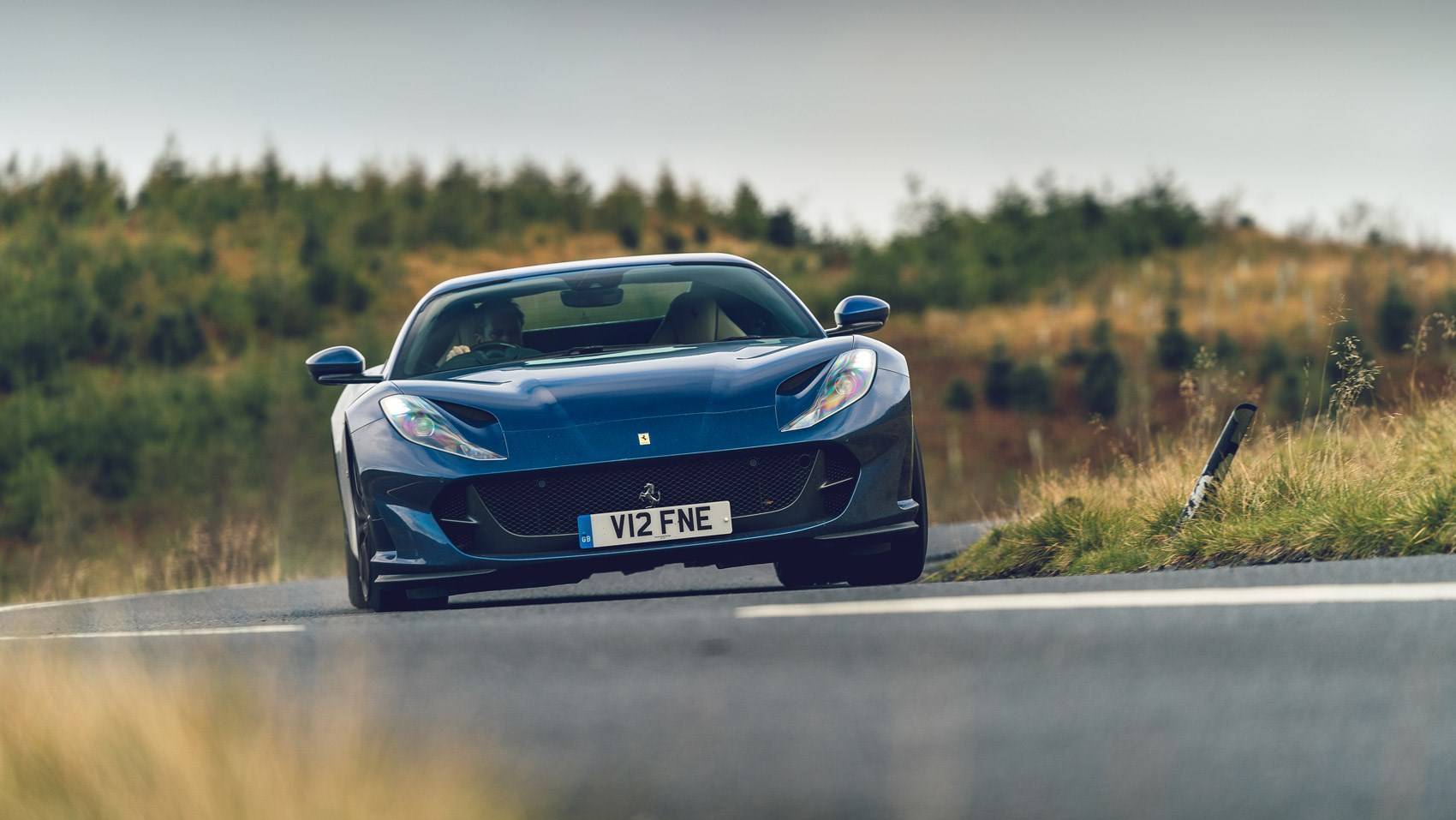
As time progresses, I’m beginning to feel more comfortable working the GTS harder, if still pondering whether I’d trade some agility for a calmer kind of feel on fast roads like this – as well as whether I actually want to disengage all safety systems to discover how this chassis really behaves. There’s definitely more of an edge to these dynamics than Ferrari’s mid-engined models.
Out in the chilly countryside, the roads we’ve picked have significant undulation and tighter twists and turns, so you don’t need quite so much commitment to really dig in to this extraordinary chassis. What you do need is tyre temperature. There’s a graphic to the right of the 812’s steering wheel that shows when the Pirellis are warmed, and in the cold and damp it takes an age for the tyres to go ‘green’, the fronts first as I work the steering hard, the rears later as I’m being a bit throttle shy. Then bingo, four green tyres, more grip, virtuous circle.
It’s actually startling to feel out just how much mechanical grip the 812 can muster with ESC off, even in damp and cold conditions. Push through that grip with a bung of steering and squirt of throttle and it immediately wants to bite and straighten, almost like the stability control isn’t entirely disabled, and certainly with far more aggression than an F8 – clearly the four-wheel steering feeds in here, but apparently the new electric steering also adds subtle torque hints to help a driver correct slides. I can’t say I process any of that stuff working away, just that the GTS responds better to big sends than tentative squirts past its limits. I’ve never driven a car that wants to straighten quite so aggressively, and together with yelps from the V12 this feels as close to lion-taming as you’ll get on four wheels.

But breaching its limits helps me fully trust the 812 GTS. It’s grippy, unbelievably agile, and so easy for throttle, gearshifts, brakes and steering to gel into a fast and smooth tempo, even if I never quite shake the lurking apprehension that this near-800bhp rear-drive weapon is a very senior piece of machinery. Respect is definitely due, in both senses of the phrase.
With the sun warming the sky, I squeeze that V12 past 5500rpm, unleashing a hedonistic rush of noise and speed as the needle breaches 8500rpm with the sound distilled into a fierce single-note howl. Modern turbocharged engines are marvellous things, but the response, linearity, sound and sheer bandwidth delivered here are all reminders of what we’ve lost in the march of progress – and Ferrari assures us the naturally-aspirated V12 is here for the long term, even if it is hybridised. Amen to that.
Бархатный сезон: Ferrari представила две новинки с открытым верхом

Скудерия Ferrari приурочила к Франкфуртскому автосалону премьеру двух кабриолетов – среднемоторного F8 Spider и переднемоторного 812 GTS, причём последний позиционируется как преемник культовой модели 365 GTS/4 Daytona полувековой давности.
Ровно полвека назад, в 1969 году Ferrari представила во Франкфурте прототип спайдера на базе купе Daytona и через два года запустила его в серийное производство.
С тех пор регулярных моделей с открытым веером и расположенным спереди мотором V12 в арсенале Ferrari не было.
Знатоки, конечно, вспомнят относительно свежие 550 Barchetta Pininfarina, Superamerica и F60America, но они проходили по ведомству ограниченных серий, то есть стояли особняком от основной модельной линейки.
Ferrari 812 GTS – это как раз регулярная модель, хотя, возможно, и последняя с «атмосферником» V12, так что ажиотаж среди автомобильных коллекционеров ей обеспечен. Технически новый спайдер практически во всём идентичен купе 812 Superfast с поправкой, разумеется, на складной верх.
Он у 812 GTS жёсткий и убирается всего за 14 секунд на скорости до 45 км/ч. Верхняя часть кормы – оригинальная, с волнообразными продольными выступами, выполняющими роль дуги безопасности. Между ними имеется подъёмное окошко, которое можно использовать как ветрозащитный экран при езде без крыши.
«Форточки» позади дверей глухие – они несут исключительно эстетическую нагрузку, визуально облегчают профиль. Между выхлопными патрубками установлен новый более сложный диффузор, компенсирующий уменьшение прижимной силы в связи с изменением формы крышки багажника. Для чемоданов выделено всего 210 л.
Под капотом Ferrari 812 GTS установлен хорошо известный 6,5-литровый атмосферный V12 с непосредственным впрыском топлива. Он развивает максимальные 800 л.с. при 8500 об/мин и 718 Нм при 7000 Нм. Коробка передач – 7-ступенчатая автоматическая с двумя сцеплениями. До 100 км/ч автомобиль разгоняется менее чем за 3 секунды, максимальная скорость – 340 км/ч.
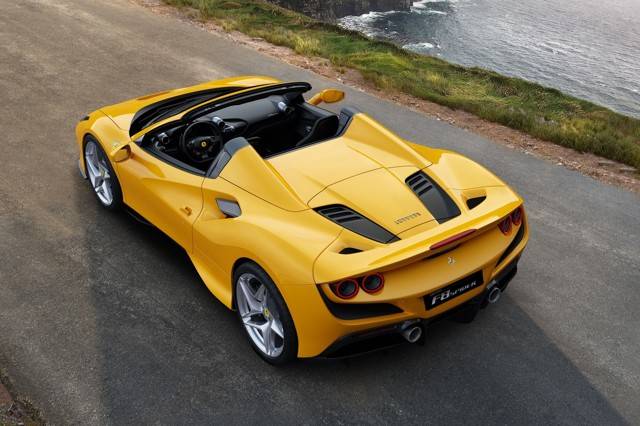 Ferrari F8 Spider
Ferrari F8 Spider
Динамические характеристики у Ferrari F8 Spider схожие: «максималка» – 340 км/ч, разгон до «сотни» – за 2,9 с, но компоновка у него среднемоторная и вся техническая начинка позаимствована у купе F8 Tributo, дебютировавшего в конце февраля. 3,9-литровая «битурбовосьмёрка» установлена за спинками кресел и выдаёт максимальные 720 л.с. при 8000 об/мин и 770 Нм при 3250 об/мин, в паре с ней трудится 7-ступенчатая АКП с двумя сцеплениями.
Двухсекционный жёсткий верх F8 Spider так же как и у 12-цилиндрового собрата складывается всего за 14 секунд на скорости до 45 км/ч. Двигатель из-за сложенных панелей снаружи, к сожалению, не виден. Сухая масса среднемоторного спайдера составляет 1400 кг против 1330 у купе F8 Tributo.
Электронные ассистенты унаследованы от купе в полном объёме, наиболее интересными из которых являются фирменная система контроля скольжений Side Slip Angle Control версии 6.1 и система Ferrari Dynamic Enhancer (FDE+), регулирующая тормозное усилие индивидуально на каждом колесе.
В дорогу F8 Spider позволяет взять 200 л багажа.
Обе новинки Ferrari появятся в продаже до конца текущего года, цены пока не объявлены. В России, к слову, спрос на новые модели Скудерии невелик: в первом полугодии 2019-го, согласно данным регистраций, на учёт встали всего 14 «жеребцов», шесть из которых – это наиболее доступный купе-кабриолет под названием Portofino.
Give me some spec details first…
Compared with the 730bhp F12, the 812’s predecessor, Ferrari has introduced a longer stroke plus 350 bar direct injection, revised control of variable-geometry inlet tracts, a compression ratio upped just a fraction to 13.6:1 and a shrieky, non-turbocharged 8900rpm peak engine speed, far above rivals from Aston and Bentley that serve up less performance for less graft. Oh, and Ferrari has shortened the seven-speed dual-clutch gearbox’s ratios six per cent so you can fast-forward to the good bits even quicker.
All this equates to 789bhp, 0-124mph in 8.3 seconds, a soundtrack that’d have the Philharmonic downing tools, and a large side order of intimidation when you squeeze that drilled throttle pedal to its stop.
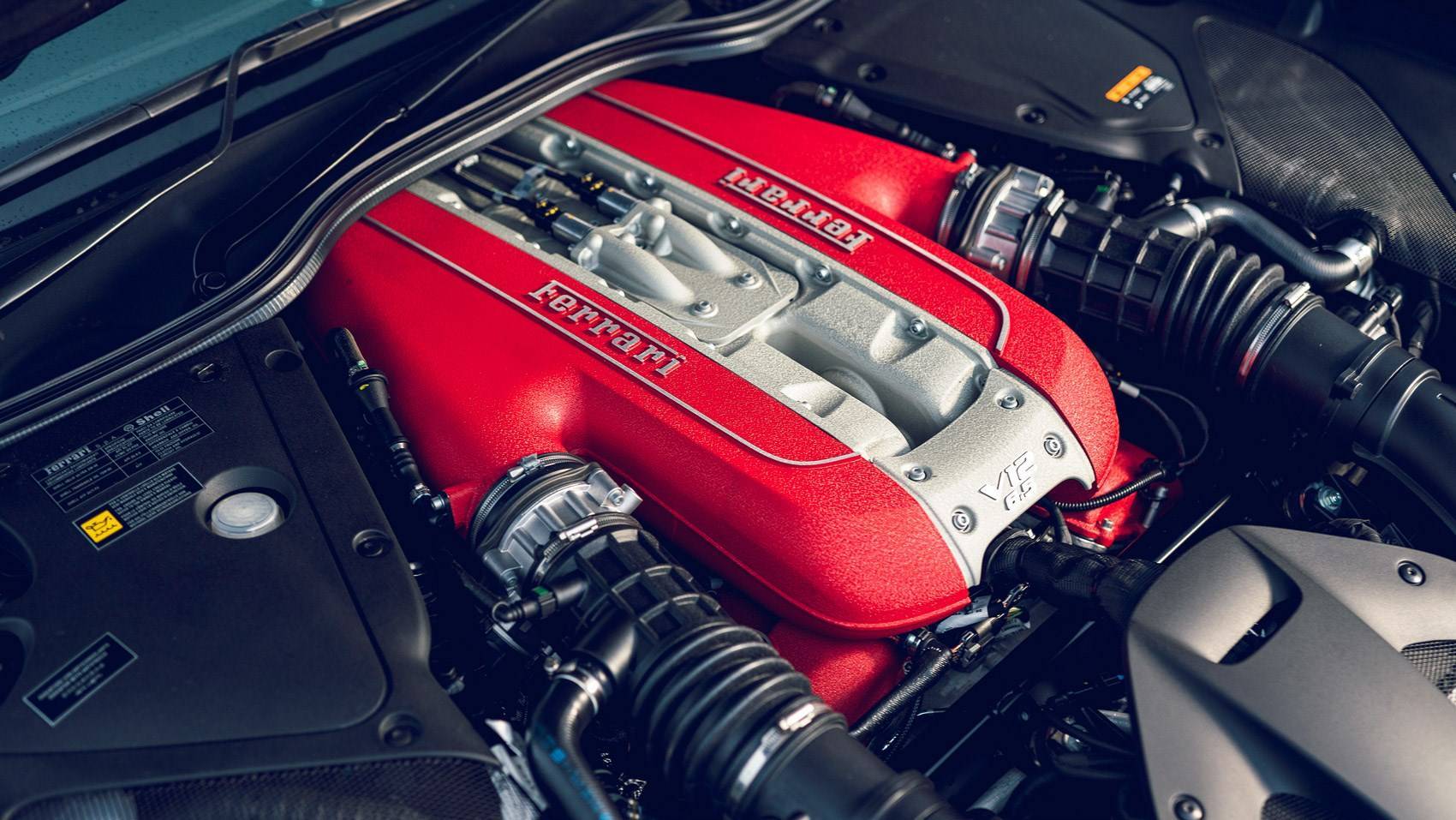
At a lightest of 1645kg without fluids, the 812 GTS weighs over 200kg less than Aston’s DBS Superlegerra Volante rival, but it’s still no featherweight. Two things, though: 1) the V12 is pushed so far back behind the front axle it looks to have had a very tidy shunt, and a transaxle shifts weight further rearwards still, so 53 per cent of the car’s weight is distributed to the rear, and much of the bulk kept within the wheelbase, and 2), it has four-wheel steering and Ferrari’s long established sneezy-quick steering.
The foldable roof’s a nifty device, and rotates through 180º then disappears quietly under the tonneau cover in 14 seconds. Structural bracing adds 120kg, but the roof’s neatly integrated into the design, with attractive rear buttresses flowing into a re-designed rear deck, and a profile that barely changes roof up or down because the difference is basically a small chunk of roof in the middle, a bit like a targa top. The diffuser at the lower rear of the 812 is modified to aerodynamically compensate for bodywork changes. The new hardtop includes, behind the seats, a vertical pane of glass that can drop for an invigorating blast of fresh air and V12 music, even with the roof up.
Let’s get started!

The driving position is pretty conventional and friendly enough to just jump in and go, the trim more racy-focused than GT-luxurious (and still with Ferrari’s older infotainment), and the interior just as spacious as the coupe, but my 6ft 1in would do better with a seat that went a little further back and dropped lower.
The cockpit itself remains a bubble of calm, apparently helped by two L-shaped flaps on the upper corners of the windscreen frame, but the ride has a gnarlier edge than Ferrari’s mid-engined V8s and the DBS, in both Sport and Race settings, though Bumpy Road mode softens brittle edges while retaining perfect control. There’s a similarly big step in powertrain settings between Sport and Race – in the former the transmission shifts rapidly by any standards and throttle response is still pretty electric, if with a nod to refinement, but pull a shift paddle a few times in Race and pin the throttle and it’s like the slightly wet thud of missiles leaving a silo.
Say hello to the Ferrari 812 GTS — the first true convertible V12 Ferrari in 50 years
It’s been a while since we’ve seen a front-engined V12 Ferrari in drop-top form. The 812 Superfast is a stunning machine, but if you like, it’s now possible to use the epic car for open-air motoring.
Enter the 812 GTS, effectively the first Ferrari since the 1969 365 GTS4 to combine 12 cylinders with a convertible layout. That car was more popularly known as the Daytona Spider.
Read more: I drove a $474,000 Ferrari 812 Superfast to see if the most powerful Ferrari in the world is worth the price tag — here’s the verdict
The 812 GTS gets a retractable hardtop that can open in 14 seconds at speeds of up to about 30 mph, Ferrari said in a statement. The rear compartment has been adjusted to avoid compromising the 812 Superfast’s already somewhat limited luggage space, and there’s a special windscreen that can be raised and lowered depending on whether the top is up or down.
Open-air V12’ing. Ferrari
“On the spider version of the 812 Superfast, the entire rear of the car — roof, tonneau cover and luggage compartment — has been redesigned,” Ferrari said in a statement.
“The idea was to lend the car a new blend of sleekness and balance, thanks to two buttresses beneath which the roof movement mechanism is stowed. The buttresses were designed to visually embody a sense of forward thrust and lend the side windows a signature look that would set the spider apart from the berlinetta.”
Ferrari luxury on the inside. Ferrari
“our special series limited editions have been launched: the 550 Barchetta Pininfarina in 2000, the Superamerica in 2005, the SA Aperta in 2010 and, most recently, the F60 America, of which just ten were built to celebrate Ferrari’s 60th year on the American market in 2014,” Ferrari said.
The rear compartment and trunk-deck was redesigned. Ferrari
The 812 GTS carries the same hulking powerplant as the Superfast, a 2018 Business Insider Car of the Year finalist. The 789-horsepower V12 makes the 812 the most potent Ferrari in history. When I tested the car last year, I enjoyed a $474,000 version, although the base version of the vehicle stickers at about $370,000.
Expect a similarly equipped 812 GTS to cost a bit more when it goes on sale.
Give me some spec details first…
Compared with the 730bhp F12, the 812’s predecessor, Ferrari has introduced a longer stroke plus 350 bar direct injection, revised control of variable-geometry inlet tracts, a compression ratio upped just a fraction to 13.6:1 and a shrieky, non-turbocharged 8900rpm peak engine speed, far above rivals from Aston and Bentley that serve up less performance for less graft. Oh, and Ferrari has shortened the seven-speed dual-clutch gearbox’s ratios six per cent so you can fast-forward to the good bits even quicker.
All this equates to 789bhp, 0-124mph in 8.3 seconds, a soundtrack that’d have the Philharmonic downing tools, and a large side order of intimidation when you squeeze that drilled throttle pedal to its stop.
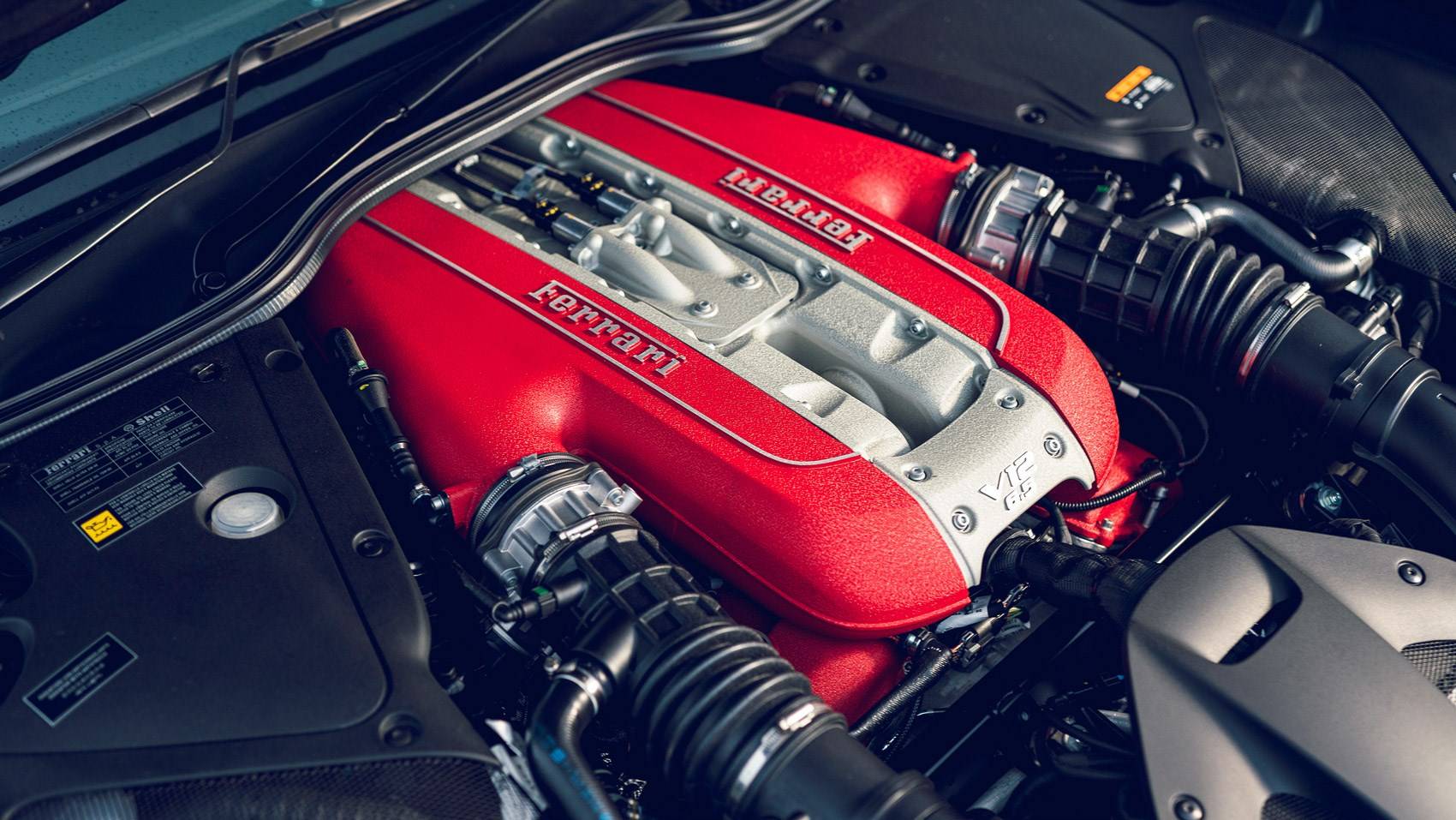
At a lightest of 1645kg without fluids, the 812 GTS weighs over 200kg less than Aston’s DBS Superlegerra Volante rival, but it’s still no featherweight. Two things, though: 1) the V12 is pushed so far back behind the front axle it looks to have had a very tidy shunt, and a transaxle shifts weight further rearwards still, so 53 per cent of the car’s weight is distributed to the rear, and much of the bulk kept within the wheelbase, and 2), it has four-wheel steering and Ferrari’s long established sneezy-quick steering.
The foldable roof’s a nifty device, and rotates through 180º then disappears quietly under the tonneau cover in 14 seconds. Structural bracing adds 120kg, but the roof’s neatly integrated into the design, with attractive rear buttresses flowing into a re-designed rear deck, and a profile that barely changes roof up or down because the difference is basically a small chunk of roof in the middle, a bit like a targa top. The diffuser at the lower rear of the 812 is modified to aerodynamically compensate for bodywork changes. The new hardtop includes, behind the seats, a vertical pane of glass that can drop for an invigorating blast of fresh air and V12 music, even with the roof up.
Pushing on in the twisties

As time progresses, I’m beginning to feel more comfortable working the GTS harder, if still pondering whether I’d trade some agility for a calmer kind of feel on fast roads like this – as well as whether I actually want to disengage all safety systems to discover how this chassis really behaves. There’s definitely more of an edge to these dynamics than Ferrari’s mid-engined models.
Out in the chilly countryside, the roads we’ve picked have significant undulation and tighter twists and turns, so you don’t need quite so much commitment to really dig in to this extraordinary chassis. What you do need is tyre temperature. There’s a graphic to the right of the 812’s steering wheel that shows when the Pirellis are warmed, and in the cold and damp it takes an age for the tyres to go ‘green’, the fronts first as I work the steering hard, the rears later as I’m being a bit throttle shy. Then bingo, four green tyres, more grip, virtuous circle.
It’s actually startling to feel out just how much mechanical grip the 812 can muster with ESC off, even in damp and cold conditions. Push through that grip with a bung of steering and squirt of throttle and it immediately wants to bite and straighten, almost like the stability control isn’t entirely disabled, and certainly with far more aggression than an F8 – clearly the four-wheel steering feeds in here, but apparently the new electric steering also adds subtle torque hints to help a driver correct slides. I can’t say I process any of that stuff working away, just that the GTS responds better to big sends than tentative squirts past its limits. I’ve never driven a car that wants to straighten quite so aggressively, and together with yelps from the V12 this feels as close to lion-taming as you’ll get on four wheels.

But breaching its limits helps me fully trust the 812 GTS. It’s grippy, unbelievably agile, and so easy for throttle, gearshifts, brakes and steering to gel into a fast and smooth tempo, even if I never quite shake the lurking apprehension that this near-800bhp rear-drive weapon is a very senior piece of machinery. Respect is definitely due, in both senses of the phrase.
With the sun warming the sky, I squeeze that V12 past 5500rpm, unleashing a hedonistic rush of noise and speed as the needle breaches 8500rpm with the sound distilled into a fierce single-note howl. Modern turbocharged engines are marvellous things, but the response, linearity, sound and sheer bandwidth delivered here are all reminders of what we’ve lost in the march of progress – and Ferrari assures us the naturally-aspirated V12 is here for the long term, even if it is hybridised. Amen to that.
Pushing on in the twisties

As time progresses, I’m beginning to feel more comfortable working the GTS harder, if still pondering whether I’d trade some agility for a calmer kind of feel on fast roads like this – as well as whether I actually want to disengage all safety systems to discover how this chassis really behaves. There’s definitely more of an edge to these dynamics than Ferrari’s mid-engined models.
Out in the chilly countryside, the roads we’ve picked have significant undulation and tighter twists and turns, so you don’t need quite so much commitment to really dig in to this extraordinary chassis. What you do need is tyre temperature. There’s a graphic to the right of the 812’s steering wheel that shows when the Pirellis are warmed, and in the cold and damp it takes an age for the tyres to go ‘green’, the fronts first as I work the steering hard, the rears later as I’m being a bit throttle shy. Then bingo, four green tyres, more grip, virtuous circle.
It’s actually startling to feel out just how much mechanical grip the 812 can muster with ESC off, even in damp and cold conditions. Push through that grip with a bung of steering and squirt of throttle and it immediately wants to bite and straighten, almost like the stability control isn’t entirely disabled, and certainly with far more aggression than an F8 – clearly the four-wheel steering feeds in here, but apparently the new electric steering also adds subtle torque hints to help a driver correct slides. I can’t say I process any of that stuff working away, just that the GTS responds better to big sends than tentative squirts past its limits. I’ve never driven a car that wants to straighten quite so aggressively, and together with yelps from the V12 this feels as close to lion-taming as you’ll get on four wheels.

But breaching its limits helps me fully trust the 812 GTS. It’s grippy, unbelievably agile, and so easy for throttle, gearshifts, brakes and steering to gel into a fast and smooth tempo, even if I never quite shake the lurking apprehension that this near-800bhp rear-drive weapon is a very senior piece of machinery. Respect is definitely due, in both senses of the phrase.
With the sun warming the sky, I squeeze that V12 past 5500rpm, unleashing a hedonistic rush of noise and speed as the needle breaches 8500rpm with the sound distilled into a fierce single-note howl. Modern turbocharged engines are marvellous things, but the response, linearity, sound and sheer bandwidth delivered here are all reminders of what we’ve lost in the march of progress – and Ferrari assures us the naturally-aspirated V12 is here for the long term, even if it is hybridised. Amen to that.
Say hello to the Ferrari 812 GTS — the first true convertible V12 Ferrari in 50 years
It’s been a while since we’ve seen a front-engined V12 Ferrari in drop-top form. The 812 Superfast is a stunning machine, but if you like, it’s now possible to use the epic car for open-air motoring.
Enter the 812 GTS, effectively the first Ferrari since the 1969 365 GTS4 to combine 12 cylinders with a convertible layout. That car was more popularly known as the Daytona Spider.
Read more: I drove a $474,000 Ferrari 812 Superfast to see if the most powerful Ferrari in the world is worth the price tag — here’s the verdict
The 812 GTS gets a retractable hardtop that can open in 14 seconds at speeds of up to about 30 mph, Ferrari said in a statement. The rear compartment has been adjusted to avoid compromising the 812 Superfast’s already somewhat limited luggage space, and there’s a special windscreen that can be raised and lowered depending on whether the top is up or down.
Open-air V12’ing. Ferrari
“On the spider version of the 812 Superfast, the entire rear of the car — roof, tonneau cover and luggage compartment — has been redesigned,” Ferrari said in a statement.
“The idea was to lend the car a new blend of sleekness and balance, thanks to two buttresses beneath which the roof movement mechanism is stowed. The buttresses were designed to visually embody a sense of forward thrust and lend the side windows a signature look that would set the spider apart from the berlinetta.”
Ferrari luxury on the inside. Ferrari
“our special series limited editions have been launched: the 550 Barchetta Pininfarina in 2000, the Superamerica in 2005, the SA Aperta in 2010 and, most recently, the F60 America, of which just ten were built to celebrate Ferrari’s 60th year on the American market in 2014,” Ferrari said.
The rear compartment and trunk-deck was redesigned. Ferrari
The 812 GTS carries the same hulking powerplant as the Superfast, a 2018 Business Insider Car of the Year finalist. The 789-horsepower V12 makes the 812 the most potent Ferrari in history. When I tested the car last year, I enjoyed a $474,000 version, although the base version of the vehicle stickers at about $370,000.
Expect a similarly equipped 812 GTS to cost a bit more when it goes on sale.
ИМПЕРИЯ ЧУВСТВ
Темперамент 812 Superfast таков, что скачок стрелки тахометра с холостых до красной зоны происходит в мгновение ока. Разгон до 100-км/ч занимает 2.9 с — поистине феноменальный результат для монопривода! Отметку в 200-км/ч машина пересекает спустя 7.9 с после старта, но верифицировать эту цифру реально только на закрытой трассе: в городских условиях возможность утопить акселератор газа в пол появляется досадно редко. Попривыкнув к сумасшедшей динамике, замечаешь идеальную линейность откликов двигателя и пронзительную отзывчивость в диапазоне от 5000 оборотов до предельных 8900. С эластичностью здесь тоже полная идиллия: шестая передача позволяет уверенно разгоняться с 50-км/ч до максимальной скорости. А на трассе 812 Superfast изумляет тишиной в салоне и умеренностью аппетита — расстояние между заправками может составлять 700-км!

Основным узлом трансмиссии служит 7ступенчатая коробка передач с двумя сцеплениями F1 DCT — очень быстрая и, что важно, весьма комфортная при неспешной езде. Похвалы заслуживают форма и расположение подрулевых «лепестков», управляющих переключениями: пальцы обнаруживают их с первой попытки. Само рулевое колесо — понастоящему гоночное, сверх меры перегруженное функциями
На него вынесены кнопки управления стартером, указателями поворота, стеклоочистителями и много чем еще. Тут же находится селектор системы управления скольжениями SSC, которой подчинены система стабилизации CST и трекшн-контроль F1-Trac. В ее компетенцию также входит изменение алгоритмов работы коробки передач и адаптивных амортизаторов SCM
Само рулевое колесо — понастоящему гоночное, сверх меры перегруженное функциями. На него вынесены кнопки управления стартером, указателями поворота, стеклоочистителями и много чем еще. Тут же находится селектор системы управления скольжениями SSC, которой подчинены система стабилизации CST и трекшн-контроль F1-Trac. В ее компетенцию также входит изменение алгоритмов работы коробки передач и адаптивных амортизаторов SCM.
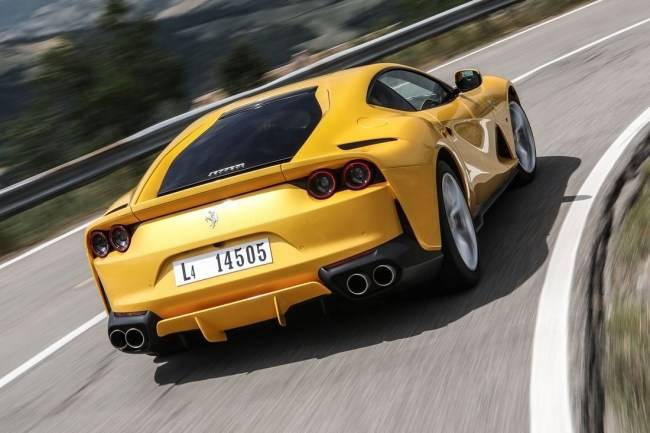
Модель 812 Superfast стала первым автомобилем марки Ferrari с электромеханическим усилителем руля. Это сделало возможным внедрение систем FPP и FPO, которые изменением усилия информируют водителя о приближении к пределу сцепных возможностей покрышек и подсказывают правильное направление вращения руля для коррекции заноса. Для пущей устойчивости у модели F12tdf было позаимствовано полноуправляемое шасси PCV — в критических ситуациях оно компенсирует снос передней оси небольшим поворотом задних колес. Идеально ровный и сухой асфальт — необходимость, если вы желаете в нюансах ощутить нейтральную поворачиваемость 812 Superfast и бездонный запас сцепления 20-дюймовых покрышек Pirelli P Zero.
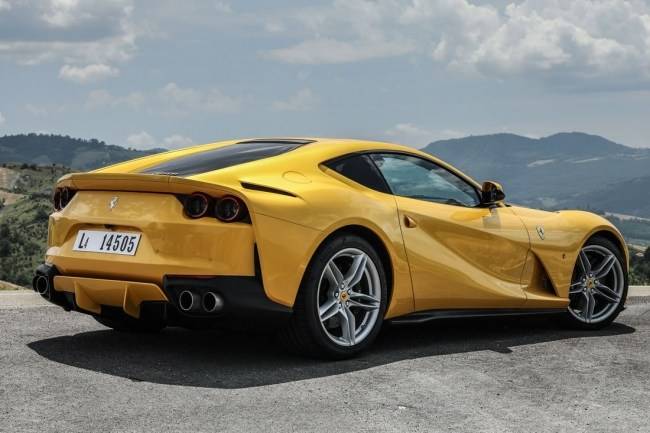
Сверхжесткая подвеска и мизерный клиренс требуют того же. Плохие дороги машине противопоказаны, поскольку даже в комфортном режиме подвески Ferrari подпрыгивает на каждом бугорке и вздрагивает на каждой трещине. Это усугубляется тем, что на неровностях 812 Superfast нервно подергивается из стороны в сторону. Машина может начать скользить даже в те моменты, когда заднее наружное колесо попадает на линии разметки! Такой же эффект возникает и при проезде луж. Легкий и острый руль, совершающий ровно два оборота от упора до упора, помогает молниеносно восстанавливать устойчивость, однако ни о каком релаксе говорить уже не приходится. При управлении этим автомобилем водитель вынужден постоянно себя контролировать, действуя как можно менее резко и размашисто. Яростные реакции и пугающие скорости в ответ на минимальные усилия — таков фирменный почерк 812 Superfast. Любовь или ненависть — решать вам.
По теме: ( из рубрики Тест-драйв авто )
Isuzu D-Max. Пикап с мотором от грузовика. Isuzu D-MaxCITROEN GRAND C4 PICASSO: Друг семьи. Citroen Grand C4 Picasso Рецепт от всех бед: Mitsubishi ASX. Mitsubishi ASX MINI Clubman: Даже не надейтесь на практичность. MINI Cooper S Clubman Ford Mondeo: Back in USA. Ford Mondeo Sedan




